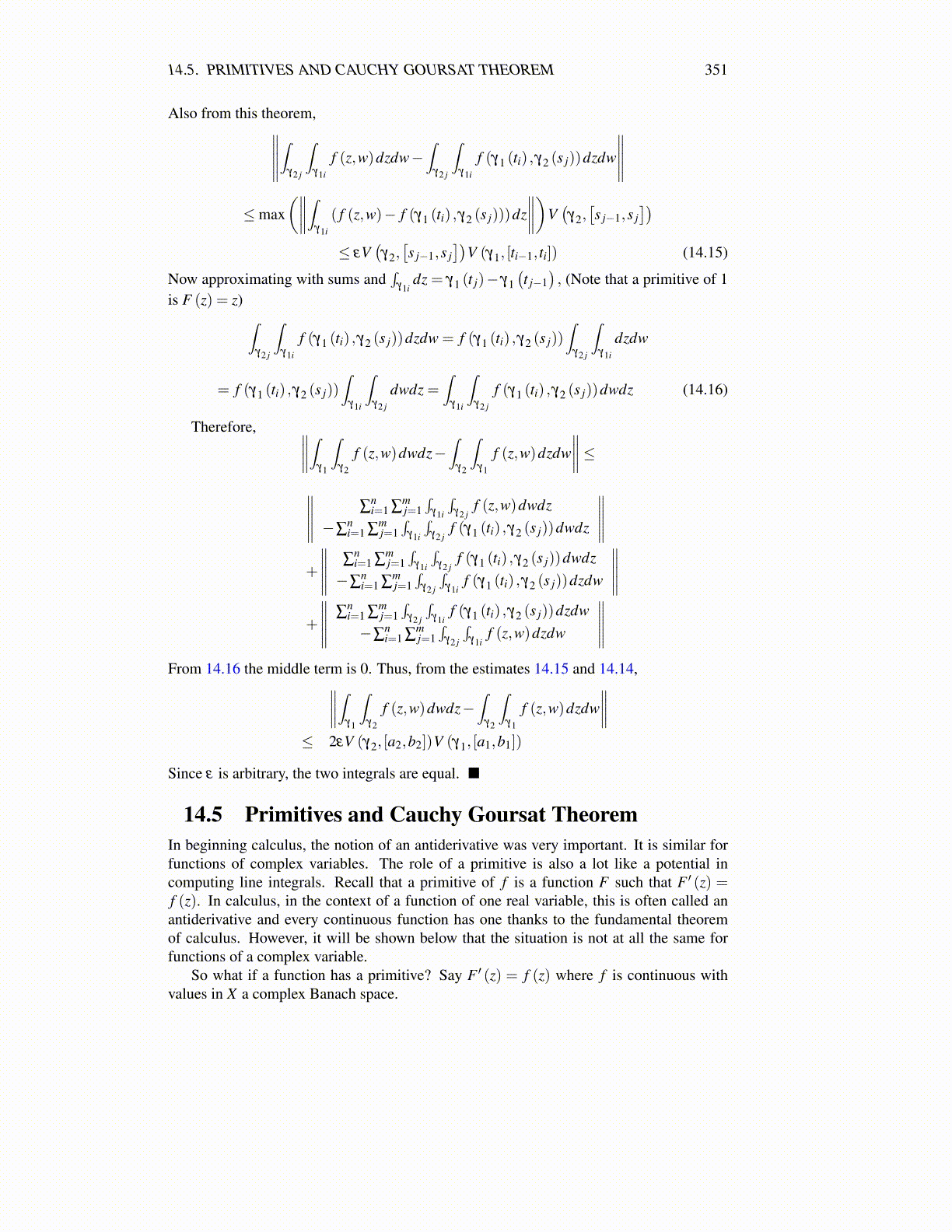
14.5. PRIMITIVES AND CAUCHY GOURSAT THEOREM 351
Also from this theorem,∥∥∥∥∥∫
γ2 j
∫γ1i
f (z,w)dzdw−∫
γ2 j
∫γ1i
f (γ1 (ti) ,γ2 (s j))dzdw
∥∥∥∥∥≤max
(∥∥∥∥∫γ1i
( f (z,w)− f (γ1 (ti) ,γ2 (s j)))dz∥∥∥∥)V
(γ2,[s j−1,s j
])≤ εV
(γ2,[s j−1,s j
])V (γ1, [ti−1, ti]) (14.15)
Now approximating with sums and∫
γ1idz = γ1 (t j)− γ1
(t j−1
), (Note that a primitive of 1
is F (z) = z) ∫γ2 j
∫γ1i
f (γ1 (ti) ,γ2 (s j))dzdw = f (γ1 (ti) ,γ2 (s j))∫
γ2 j
∫γ1i
dzdw
= f (γ1 (ti) ,γ2 (s j))∫
γ1i
∫γ2 j
dwdz =∫
γ1i
∫γ2 j
f (γ1 (ti) ,γ2 (s j))dwdz (14.16)
Therefore, ∥∥∥∥∫γ1
∫γ2
f (z,w)dwdz−∫
γ2
∫γ1
f (z,w)dzdw∥∥∥∥≤
∥∥∥∥∥ ∑ni=1 ∑
mj=1∫
γ1i
∫γ2 j
f (z,w)dwdz−∑
ni=1 ∑
mj=1∫
γ1i
∫γ2 j
f (γ1 (ti) ,γ2 (s j))dwdz
∥∥∥∥∥+
∥∥∥∥∥ ∑ni=1 ∑
mj=1∫
γ1i
∫γ2 j
f (γ1 (ti) ,γ2 (s j))dwdz−∑
ni=1 ∑
mj=1∫
γ2 j
∫γ1i
f (γ1 (ti) ,γ2 (s j))dzdw
∥∥∥∥∥+
∥∥∥∥∥ ∑ni=1 ∑
mj=1∫
γ2 j
∫γ1i
f (γ1 (ti) ,γ2 (s j))dzdw−∑
ni=1 ∑
mj=1∫
γ2 j
∫γ1i
f (z,w)dzdw
∥∥∥∥∥From 14.16 the middle term is 0. Thus, from the estimates 14.15 and 14.14,∥∥∥∥∫
γ1
∫γ2
f (z,w)dwdz−∫
γ2
∫γ1
f (z,w)dzdw∥∥∥∥
≤ 2εV (γ2, [a2,b2])V (γ1, [a1,b1])
Since ε is arbitrary, the two integrals are equal. ■
14.5 Primitives and Cauchy Goursat TheoremIn beginning calculus, the notion of an antiderivative was very important. It is similar forfunctions of complex variables. The role of a primitive is also a lot like a potential incomputing line integrals. Recall that a primitive of f is a function F such that F ′ (z) =f (z). In calculus, in the context of a function of one real variable, this is often called anantiderivative and every continuous function has one thanks to the fundamental theoremof calculus. However, it will be shown below that the situation is not at all the same forfunctions of a complex variable.
So what if a function has a primitive? Say F ′ (z) = f (z) where f is continuous withvalues in X a complex Banach space.